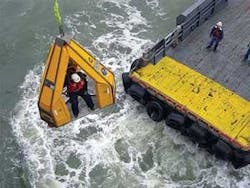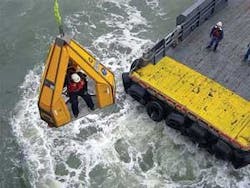Marine transfer safety evolves
The logistics of boarding offshore installations tend to be exciting for journalists who only make such trips infrequently.
My few excursions offshore involved helicopter rides. Other OGJ editors rode baskets in which they stepped onto a flotation ring and hung onto a collapsible rope net.
Industry uses various types of crane-assisted devices for personnel transfers from a crew supply boat. A crane lifts the device off a boat, swings it over the water, and hoists it onto an installation. Some of the latest models have seats or quick-release clips for riders.
In recent years, personnel transfer equipment has evolved while industry has emphasized standardized safety procedures, said Paul Liberato, president of Billy Pugh Co., Corpus Christi, Tex.
Speaking to a recent International Association of Drilling Contractors conference on health, environment, and safety in Houston, Liberato said personnel transfers “are extremely safe” because industry considers “moving people to be a critical operation.”
Rite of passage
Liberato rebukes the idea of a rite of passage for a new crew hand, who typically found himself alone on the rope basket for his first “Billy Pugh” ride because veteran crew members conspired with the crane operator to initiate the new guy with a brief dip into the water.
Unlike decades ago, industry avails itself of training schools, videos about operational procedures, preflight safety briefings, and transfer device inspections.
Liberato said the BP PLC-operated Thunder Horse semisubmersible platform reported 280,000 crane-assigned personnel transfers without any incidents. Thunder Horse’s quarters, moored on Mississippi Canyon Block 778, can accommodate more than 200 people.
Another personnel transfer device manufacturer, Reflex Marine Ltd., Aberdeen, noted that statistics on transfer accidents are lacking because no systematic data exist for crane transfers.
“Our feeling is that whilst best practice in marine transfer has improved considerably, it is still not as widespread as it could be,” said Philip Strong, Reflex Marine managing director.
From a records search, Reflex Marine assembled global information on 72 crane-transfer incidents associated with 11 deaths and 59 injuries. Of those incidents, most of which occurred since 2000, 49% involved falling, 38% involved lateral impact (swinging), and 32% involved vertical impact (heavy landing).
Strong and Liberato both said careful attention needs to be paid to the vessel choice, the crane operation, the training, and the transfer device itself, but that ultimately the human factor still figures prominently.
Helicopter safety
Although Liberato calls helicopters “the gold standard” in personnel transfer, some Gulf of Mexico operators have experienced fatal helicopter accidents. Recently, a helicopter carrying workers to Shell Oil Co.’s South Timbalier platform crashed into a southern Louisiana marsh, killing both pilots and six of the seven workers.
The National Transportation Safety Board estimates thousands of helicopter flights take off daily to shuttle people to installations off Texas and Louisiana.
Sudden changes in weather always are a risk. In my former days as a wire service reporter, I once sat in a helicopter on an elevated helipad off Texas for an unscheduled weather-related stop. The pilot said the helipad was a fueling station.
I remember how that helipad seemed rather small with nothing in sight except for water. Everything turned out fine. But before we returned to shore, I experienced a growing sense of gratefulness for the pilot’s caution and my life jacket.

